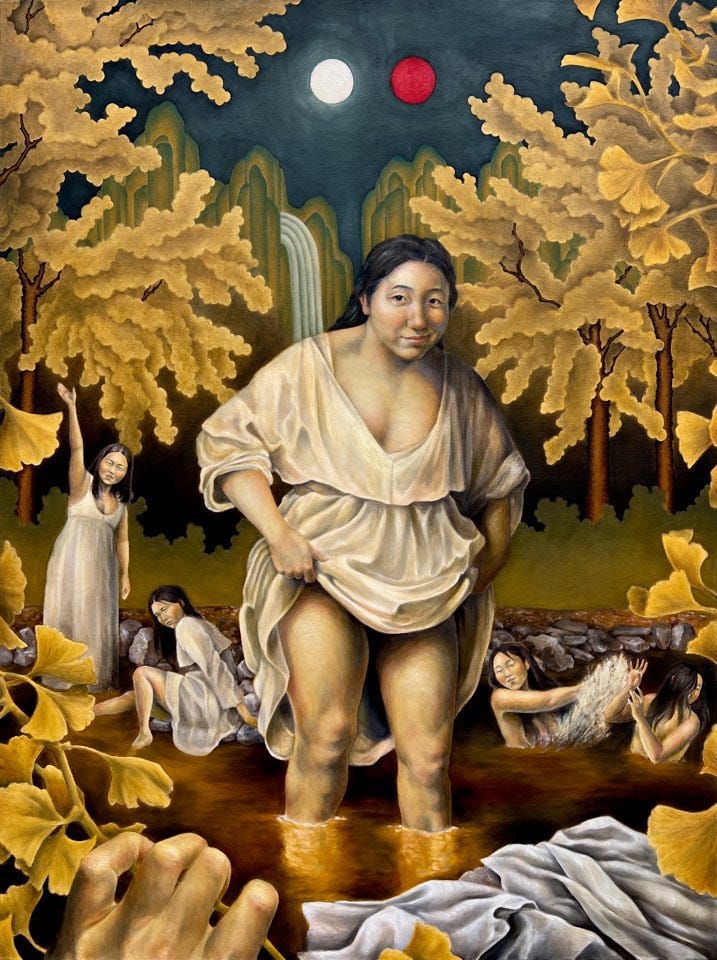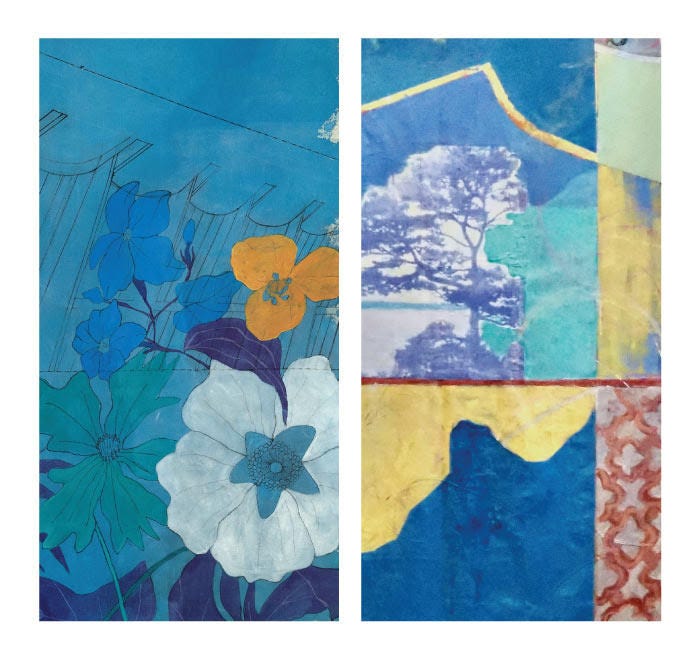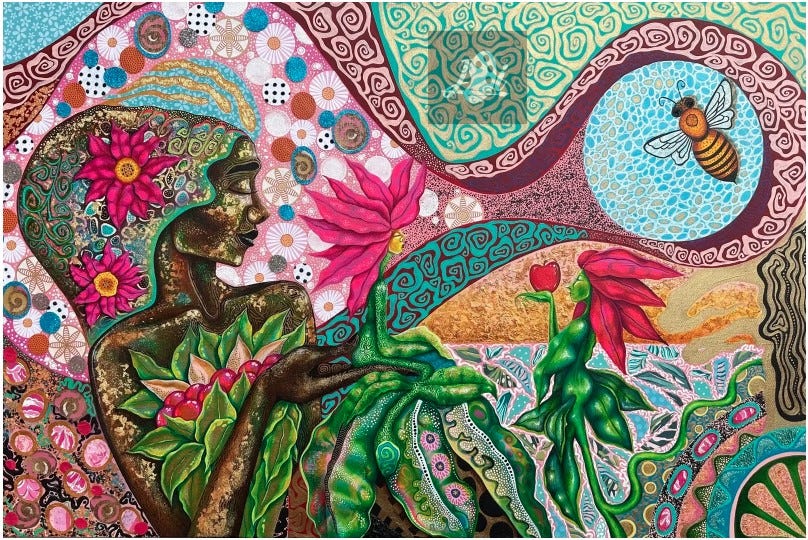Awaiting an Explosion
The Kreeger Museum's "Water in the Gas" ponders disintegration. Also: Elizabeth Casqueiro's worldly paintings and group shows at the Korean Cultural Center and Zenith Gallery
Misha Ilin, “ratking” (Kreeger Musuem)
NAMED FOR A JEAN DUBUFFET PAINTING in the Kreeger Museum's collection, "Water in the Gas" infiltrates recent work by 2022-24 Hamiltonian Artworks fellows into one of the museum's lower-level galleries. While the offerings of the four contemporary artists are diverse, the Kreeger pieces that surround them are mostly neo-primitivist modern paintings.
The exception is a predominantly green 1960 Josef Albers "Homage to the Square" that's placed in visual dialogue with Edgar Reyes's "La Tierra Olvida (The Land Never Forgets)." But where Albers's rectangles appear archetypal and immaculate, Reyes's blocks of color suggest pixels from a digital photo that's been enlarged into incoherence. And these jagged slabs are part of an unruly assemblage that also includes dried banana leaves and fragments of a felled Christopher Columbus monument. Reyes puts things together to commemorate their falling apart.
"Water in the gas" refers to a potential fault in old coal-gas systems that can lead to small explosions, explains curator Anisa Olufemi's catalog essay. The ominous phrase suits the work of Russia-born New Yorker Misha Ilin, whose sculpture is haunted by the dangers of nuclear power. Ilin turns to European myth and history for "ratking," a sculpture that depicts rodents forced into a loop by their entangled tails. The image is unnerving, yet rendered elegantly in enamel-glazed ceramic.
The multiple rats complement the repeated motifs of Isabella Whitfield's two contributions. One is a floor piece that arrays 300 child-like plaster figurines tinted in pastel shades of pink, yellow, or green. The other is a wall-mounted tapestry of 30 four-leaf clovers individually embedded into squares of white homemade paper, roughly stitched together. Both artworks intriguingly contrast abundance and ephemerality. The massed objects appear substantial, while the hues fade toward invisibility.
Repetition and fragmentation characterize Madyha J. Leghari's "sick, stroke, sea, swell," which splinters the experience of pregnancy into a series of small etchings scattered eccentrically on the wall. The pictures are earthy and stark, and sometimes as detailed as scientific illustrations, which sets the artist's personal experience in a universal biological framework. Also representing a broader context is the medium for the etchings: blocks of pink rock salt from Pakistan, the artist's homeland. Even as chaos looms, some aspects of the artist's sensibility are forever fixed in place.
Gina Bae, “I Am a Fairy and Everything is Run by Woodcutter Fantasies” (Korean Cultural Center)
THERE'S MORE THAN ONE KIND OF BIRD'S EYE VIEW, as Yu-Ching Wang demonstrates in one of two videos at the Korean Cultural Center. Her closeup study of New York pigeons is projected low on the wall, so that visitors have to adopt a pigeon-like stance in order to view the action properly. Becoming something other than your customary self is one of the themes of "Patchwork of Elsewhere: Exploring the Poetics of Home, Displacement, and Belonging," which presents work by four artists, three of them with roots in South Korea.
Wang's other video is more personal: The Taipei-born multidisciplinary artist documents her attempts to symbolically initiate a relationship with her downstairs neighbors in the Brooklyn industrial building that contains her studio. Among the objects she lowers through small holes in the floor of her space is a photo of her face, the visage of a person who is both foreign and adjacent.
Family photos and a naturalization certificate are among the personal artifacts employed by Timothy Hyunsoo Lee, who was born in Seoul and raised in New York City. Lee works mostly with gilded plates -- often containing partly obliterated images that suggest faded identity -- and blue cyanotypes. Queerness is one of his concerns, as is the crossbred character represented by a series of prints of overlaid U.S. and South Korean currency. Some of the imagery is less direct: A triptych of white rhomboids that appear to descend on blue fields is essentially abstract, but bleached at the edge of the third panel, a subtle hint of cultural atrophy.
Far more Westernized is the impressive technique of Gina Bae, a painter originally from the San Francisco area. She renders women and animals in a European Renaissance-like style, but places them before scenery that's flattened in the manner of traditional East Asian landscapes. If the figures, often nude, combine European bodies with Asian features, the iconography is all Korean. It draws on such myths as one about a bear who became human and gave birth to the country's founder. Such fertile tales seem to compel Bae, even though she has "no desire for marriage or children," according to the show's catalog.
Also included are some of Sookkyung Park's elegant sculptures, which distill the essence of natural phenomena with thousands of folds of painted paper. These representations of the sun, the moon, the sea, and a mountain may be universal, but the paper from which they're made is "a vessel of memory and familiarity" for the South Korea-born artist, says the catalog. Most of these delicate constructions have been widely exhibited in the Washington area, where Park lives. But they're lovely, and well worth another look.
Elizabeth Casqueiro, “Between Worlds” (IDB Staff Association Art Gallery)
JUXTAPOSING BUILDINGS AND VEGETATION, Elizabeth Casqueiro makes paintings that overlay the grown and the constructed. "Between Worlds," her show at IDB Staff Association Art Gallery, jumbles flowers and domes, as well as intuitive and precise, smudgy and hard-edged. The pictures in this array, some of them shown at other local venues last year, are mostly colorful, and occasionally include sprinklings of glitter.
A Portugal-born D.C. artist, Casqueiro trained as an architect. She uses renderings of steps, windows, hallways, colonnades, and other building features to conjure a sense of depth in pictures that are fundamentally flat. One exception to this strategy is "Pieces of Me," a large and entirely abstract collage-painting on rumpled white canvas with strands of painted fabric that hang from the jagged bottom border. There are no architectural details in this uncharacteristic piece, which has an intentionally unfinished quality.
Made in 2019, "Pieces of Me" is the show's earliest entry, but it seems to lead to two of the most recent ones, a pair of two-sided banners that include the title piece. These are more orderly than the earlier collage-painting, yet softer than the paintings from 2022-2024. While sections of buildings, such as a sketch of Dulles Airport, feature in the banners, they have a ghostly aspect. Casqueiro may still exist between worlds, but these lovely banners tip the balance toward the garden.
Ashley Joi, “Rebirth” (Zenith Gallery)
THE ART-STUFFED HOUSE THAT CONTAINS ZENITH GALLERY is a perpetual group show, so it's complicated to identify which works are part of "New Works by Gallery Artists + New Artist." The selection includes some of Joanathan Bessaci's carved and shaped paper collages, retained from the previous exhibition. One standout is a dynamic set of wooden hands that reach for each other and away from a swooping base, made by Margery Goldberg, the gallery's proprietor. Also eye-catching is an Anne Marchand abstract expressionist painting in which black dominoes are embedded in a pool of seemingly molten black pigment, by dots placed elsewhere in the composition.
The show's new artist is Ashley Joi, whose mixed-media collage-paintings nestle Black women amid intricate patterns, and also embed such patterns into the women's clothing, hair, and skin. The figures are integrated into fanciful depictions of the natural world, and include such characters as "Miss Love Bug Fern Fairy," whose head is framed by a corona of petals. Most complex, and most appealing, is "Rebirth," a fantasia of organic entities -- a bee, notably -- and decorative shapes. The picture combines elements of stained glass, printed fabrics, and nature illustration into a vision of a peaceable kingdom.
Water in the Gas
Through Aug. 23 at the Kreeger Museum, 2401 Foxhall Rd. NW. kreegermuseum.org. 202-337-3050.
Patchwork of Elsewhere: Exploring the Poetics of Home, Displacement, and Belonging
Through Aug. 22 at the Korean Cultural Center, 2370 Massachusetts Ave. NW. washingtondc.korean-culture.org/en. 202-939-5688.
Elizabeth Casqueiro: Between Worlds
Through Aug. 21 at IDB Staff Association Art Gallery, 1300 New York Ave. NW (13th St. entrance). idbstaffassociationartgallery.org. 202-623-3635.
New Works by Gallery Artists + New Artist
Through Aug. 30 at Zenith Gallery, 1429 Iris St. NW. zenithgallery.com. 202- 783-2963.






